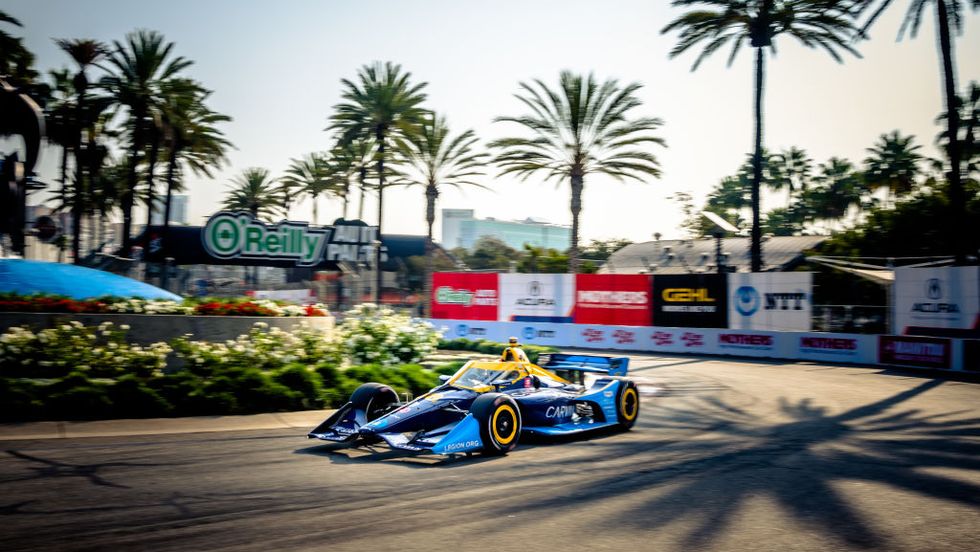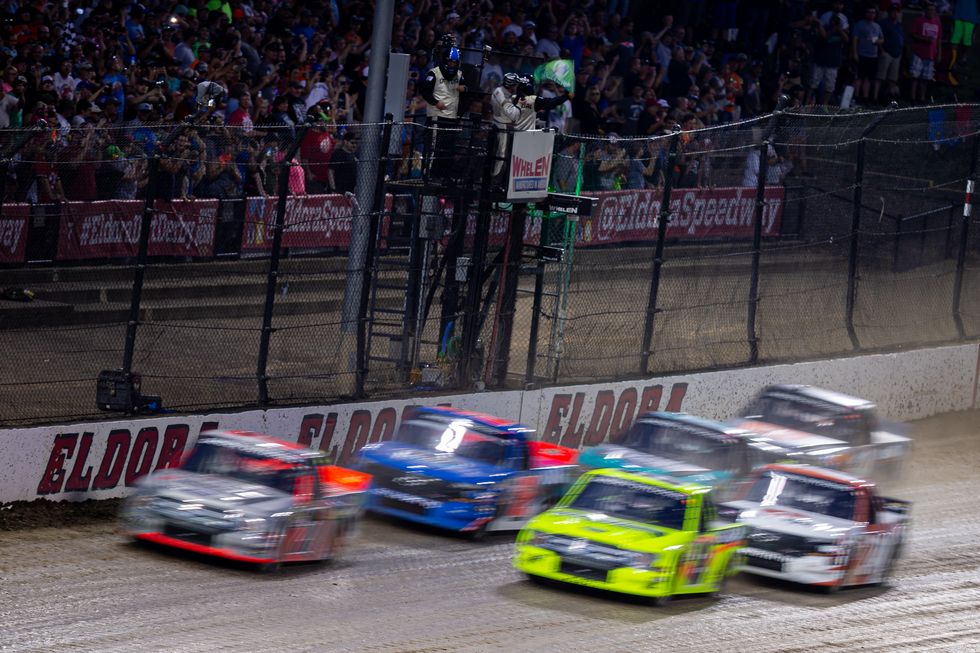- This weekend’s historic event is the first on a three-year contract between NASCAR and Chicago.
- If all goes well at Chicago, stock car racing might come out with its head high.
- But if things go even slightly sideways, cities reportedly calling NASCAR about a street race might reconsider.
With NASCAR soon to present the first street race in its 75-year history, it’s not unreasonable to look ahead to other new events it might be considering. Some in due time, of course; others, probably not at all.
The people in Daytona Beach have been offering high-banked, high-speed, long-distance Cup Series races for years, since the inaugural Southern 500 in 1950. Its cars have raced around football fields and on baseball diamonds. They’ve been on airport runways and Atlantic Ocean beaches. NASCAR has run hundreds of short-track races and more than 100 road races on permanent or temporary circuits.
And now … the Grant Park 220, the first of its 2,731 races on downtown public streets. Let’s finally check that off the aging bucket list and look ahead.
Okay, NASCAR … what’s next?
Circuit Gilles Villeneuve, Montreal
Why not a Cup-IndyCar doubleheader at the Circuit Gilles Villeneuve on the Ile Notre-Dame in Montreal? IndyCar last raced there 2002-2006 and the NASCAR Xfinity Series had a presence 2007-2012. Although the 2.710-mile road course is used primarily for the Canadian Grand Prix, it’s likely that IndyCar and NASCAR team owner Roger Penske could make it happen.
In February, Steve O’Donnell told Sports Business Journal that NASCAR wanted to take Cup to Mexico or Canada in hopes of expanding its global reach. Last year, at the World Congress of Sports, Cup president Steve Phelps said, “Our 2024 schedule will probably be the most aggressive we’ve ever had in terms of continued variation with new markets and new tracks”. (The schedule is expected to be announced before Labor Day).
At last fall’s season-ending “State of the Sport” message, Phelps spoke more on the subject. “Do we believe there’s interest north and south of the border? Yeah, there’s interest,” he said. “(NASCAR executives) Ben Kennedy and Steve O’Donnell … their phones are ringing from cities across the country that are like, ‘We’d love to host a NASCAR race at our city.’ We have calls coming from north and south of the border. Whether that happens in 2024, I don’t know. What I do know is we’re going to have continued schedule variations.”
This weekend’s historic event is the first on a three-year contract between NASCAR and Chicago. If all goes well, stock car racing might come out with its head high, its reputation greatly enhanced. But if things go even slightly sideways—disappointing attendance, bad racing, technical and logistical issues, public access gaffes, traffic snarls—those cities reportedly calling about a street race might reconsider.
The whole thing is risky, as the Eagles mournfully sing … “this could be heaven or this could be hell.”
New York, New York
Other than an eye-opening doubleheader with IndyCar in Montreal, where else might NASCAR go to broaden its national presence and try to become more mainstream? (Please, please don’t suggest Mexico).
Ideally, of course, a weekend in New York City would fulfill NASCAR’s fondest dreams. Other than Chicago and its Fortune 500 companies, where better to take stock car racing than on the Big Apple’s world-famous streets? By a factor of one hundred, though, it would be NASCAR’s most daunting challenge, one it would almost certainly fail. (FYI: International Speedway Corp.’s bid to build an 80,000-seat speedway on Staten Island in 2005-2006 ended when a jam-packed public hearing turned ugly. Cowed by the residents’ vehement opposition, the three City Councilmen wisely denied ISC’s application to build the track).
But what about the Meadowlands Sports Complex in New Jersey, across the Hudson River, within sight of New York’s skyline? IndyCar raced there—by all accounts, without much success and without much attention—between 1984 and 1991. (On second thought, maybe Cup shouldn’t try that, no matter its thirst for New York). Between 2012 and 2014, Formula 1 often talked about the 3.2-mile Port Imperial Street Circuit in New Jersey, across from New York. Despite optimistic pronouncements by both sides, those talks came to nothing).
Long Beach, California
The streets of Long Beach have welcomed racing for years, but never with the top-level stock car series. Maybe a NASCAR-IndyCar show there would attract enough attention to make it worthwhile.
The city is so accustomed to hosting high-profile events that it could easily handle a two-series weekend. But would Phelps, O’Donnell, and Kennedy go into Southern California, a market already saturated by the Busch Clash in the Los Angeles Coliseum and (in some or fashion) Auto Club Speedway at Fontana? And would NASCAR accept being a Saturday support race for IndyCar, which has a long-established fanbase in the area?
Diggin’ the Dirt
Three tracks come to mind if NASCAR wants to roll back the clock and add a “legitimate” dirt-track race. (As for Bristol: the annual ritual of hauling in dirt and covering its half-mile of asphalt doesn’t make it a “legitimate” dirt track. Never has, never will).
And while Eldora in Ohio and Knoxville in Iowa are traditional, classic, well-regarded, state-of-the-art, half-mile dirt tracks, neither has enough seating or infrastructure to accommodate a Cup race. The good news: the Springfield Mile at the Illinois State Fairgrounds has hosted 40 ARCA stock car races since 1983, making it a prime candidate for a Cup race on “real dirt.” The bad news: its proximity to speedways in St. Louis, Indianapolis, and Newton, Iowa.
Portland, Oregon
Except for the Great Northwest and that vast expanse of prairie between Fargo and Spokane, much of America is within a day’s drive of a NASCAR race. If the Xfinity and Craftsman series—and a host of open-wheel disciplines—can race at Portland (Ore) International Raceway, why not Cup? It might even lure 95-year-old Hall of Fame driver Hershel McGriff out of his latest retirement.
Don’t Hold Your Breath For …
Speedway Motorsports Inc. (with thanks to Dale Jr.) did everything right in refurbishing closed-down North Wilkesboro (N.C.) Speedway for this year’s All-Star race. Its future remains in limbo, but it seems unlikely to return to the Cup schedule unless it adds seating and infrastructure, and unless another SMI track gives up one of its dates.
Similarly, the inactive speedways at Rockingham, N.C. and Sparta, Ky. would need work if they hoped to rejoin the Cup schedule.
Chicagoland Speedway at Joliet is still alive, but lacking any major events. NASCAR president Bill France Jr. once said of Joliet, “This type of racing will rival the NFL, NBA, and Major League baseball for fan and sponsorship involvement.” That was in 2001; Chicagoland ran just 19 races before hosting its last Cup race in 2019.
If someone at corporate NASCAR has another scheduling ace tucked up his sleeve, it might be a while before he shows it.
In the meantime, the streets of Chicago will have to do.
Contributing Editor
Unemployed after three years as an Army officer and Vietnam vet, Al Pearce shamelessly lied his way onto a small newspaper’s sports staff in Virginia in 1969. He inherited motorsports, a strange and unfamiliar beat which quickly became an obsession.
In 53 years – 48 ongoing with Autoweek – there have been thousands of NASCAR, NHRA, IMSA, and APBA assignments on weekend tracks and major venues like Daytona Beach, Indianapolis, LeMans, and Watkins Glen. The job – and accompanying benefits – has taken him to all 50 states and more than a dozen countries.
He’s been fortunate enough to attract interest from several publishers, thus his 13 motorsports-related books. He can change a tire on his Hyundai, but that’s about it.
Read the full article here






